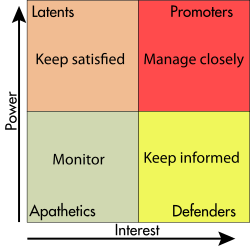Stakeholder management

Stakeholder management supports an organization's strategic objectives by interpreting and influencing both the external and internal environments and by creating positive relationships with stakeholders through the appropriate management of their expectations and agreed objectives. Stakeholder management is a process and control that must be planned and guided by underlying principles.
Stakeholder management within businesses, organizations, or projects prepares a strategy utilising information (or intelligence) gathered during the following common processes:
- Stakeholder identification - Catalogues interested parties either internal or external to the organisation or project. A stakeholder map is helpful for identifying the stakeholders.[1]
- Stakeholder analysis - Recognises and acknowledges the needs, concerns, wants, authority, common relationships, and interfaces to stakeholders and aligns this information within the stakeholder matrix.
- Stakeholder matrix - Positions stakeholders according to the level of influence, impact, or enhancement they may provide to the business or its projects. There are many simple 2x2 models in the literature and a few more sophisticated tools such as the Stakeholder Circle[2]
- Stakeholder engagement - Different from stakeholder management in that engagement does not seek to develop the project/business requirements, delineate problems, create solutions, or establish roles and responsibilities. It is primarily focused at getting to know and understand each other at the executive level. Engagement is the opportunity to discuss and agree on expectations of communication and, primarily, to agree on a set of values and principles that all stakeholders will abide by.
- Communicating information - Expectations are established and agreed to for the manner in which communications are managed between stakeholders - who receives communications, when, how, and to what level of detail. Protocols may be established, including security and confidentiality classifications.
Stakeholder agreements is a collection of agreed decisions between stakeholders. This may be the lexicon of an organisation or project, the values of an initiative, the objectives or model of the organisation, etc. These should be signed by key stakeholder representatives.
Contemporary or modern business and project practice favours transparent, honest, and open stakeholder management processes.[citation needed]
References
- ↑ Stakeholder Management Overview, Rob Llewellyn, May 2009
- ↑ Stakeholder Relationship Management,Dr. Lynda Bourne, 2007